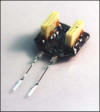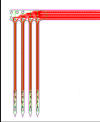1
Multi-Electrode Array ICS-32
Size 4x4 mm, 100, silicon spikes 1,0-1,5 mm long
It is a base interface for recording neural signals from populations of neurons over a long period of time. Solution includes Multi-Electrode Arrays (see left picture), the Cerebus� 128 Channel Data Acquisition System, and a Surgical Training Program.
Each spike in array is connected to a very fine wire that provides an electrical connection to the "outside world". The array is inserted into the cortex with a special patented device so that the electrode spikes penetrate to exactly the correct depth to interface with a stable population of cortical neurons on a long term basis.
N/A
2
CerePort� 128
96-Electrode Chronic Microelectrode Array Assembly
Cyberkinetics Neurotechnology Systems, Inc.
CerePort� 128 is a ready to use 134-pin chronic high-density percutaneous connector system designed for a wide range of experiments on human and big animals.
3
ICS-32
96-Electrode Chronic Microelectrode Array Assembly
ICS-96 is a 108-pin chronic percutaneous connector that measures 37x17x8 mm was designed for use in large animals such as monkeys. Contain 96 or 100 electrodes per array, 96 active electrodes.
$2250
Note
All prices get from Andrew Gotshalk, Cyberkinetics Inc.
The pneumatically-actuated impulse inserter (see also INSERTER page) has been designed to use a momentum transfer technique to insert the 100-electrode arrays into feline and primate cerebral cortical tissues in under 200 microseconds. This high velocity insertion has been used in scores of array implantations and produces complete insertions of the array with little bleeding and minimal tissue insult. The inserter has a number of variable parameters which allow the user to implant Cyberkinetics electrode arrays into a wide variety of neural tissues.
4
Chronic Research Probe
Choice from a catalog
Probe material: Silicon substrate with silicon dioxide/nitride insulation. Electrode material: Iridium. Electrode per probe: 16 or 32 channel. Probe thickness: 15um. Ribbon cable thickness - 5um. Ribbon cable length - 10mm. Connector: Omnetics NANO. Insulation material Epo-Tek 353ND-T (see more...)
5
Michigan Probes
4 shrunks, 2 mkm long, spaced at 100 mkm
6
Neurotrophic Electrode
The tip is introduced at an angle of 45 degrees from the surface of the cortex, and inserted for a distance of 5 to 6 mms until the part of the wire on the surface of the cortex limits its insertion depth. The wire is brought along the surface and then rises above it with continuous coiling until it reaches its connector on the skull.





